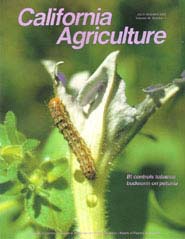All Issues

Bt controls tobacco budworm on petunia
Cover:
A resistant tobacco budworm feeds on petunia, unaffected by insecticide applications. Researchers at UC are now managing the pest with Bacillus thuringiensis (Bt), a bacterium-derived biological control agent. UC;s overall agenda for non-chemical pest control research is set forth in a new book: Beyond Pesticides.
Photo by Marvin G. Kinsey
July-August 1992
Volume 46, Number 4
Volume 46, Number 4





